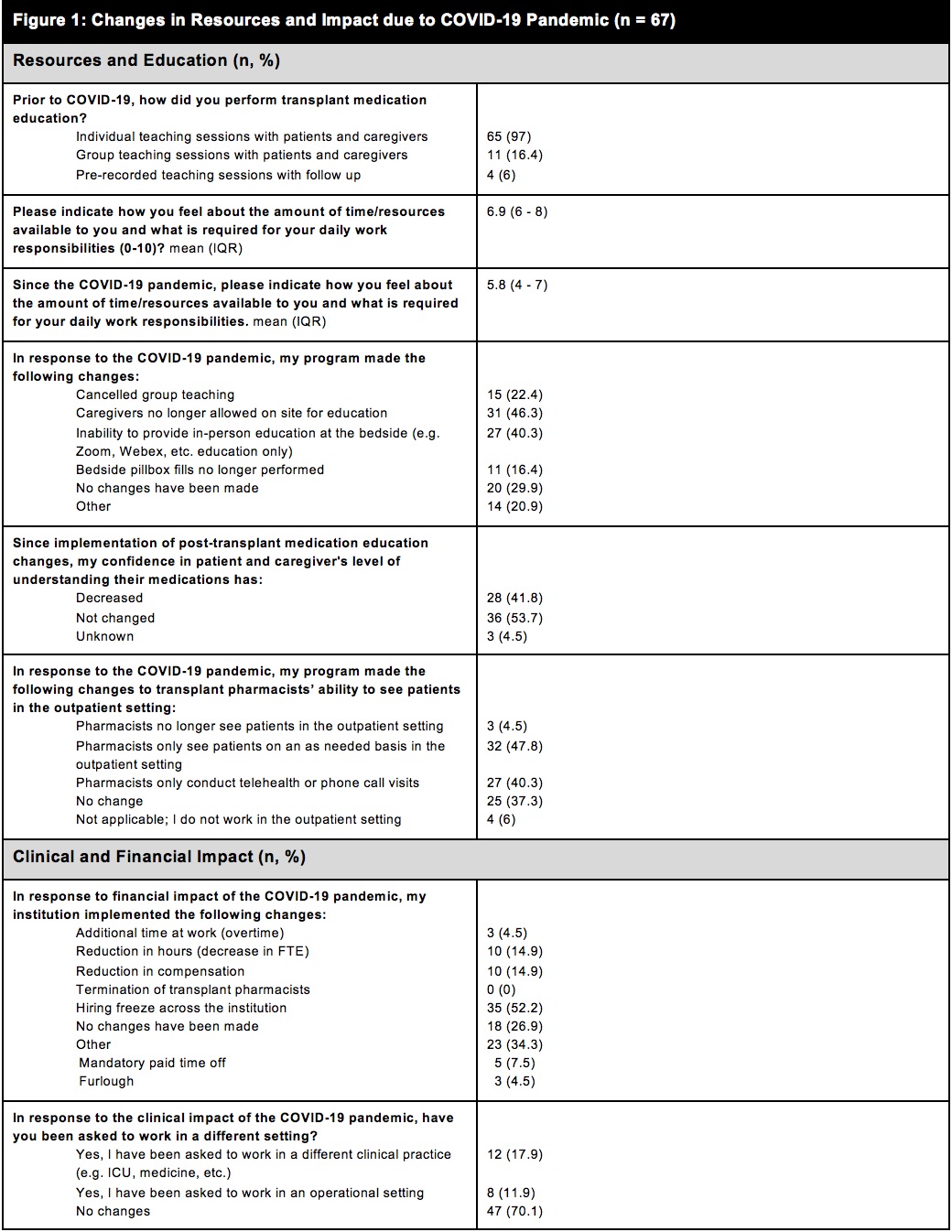Impact of the Covid-19 Pandemic on Transplant Pharmacist Workforce
1Department of Pharmacy, Loyola University Medical Center, Maywood, IL, 2Department of Pharmacy, NYU Langone Health, New York, NY, 3Medicine and Section of Heart Failure, Cardiac Transplant, and Mechanical Circulatory Support, Stanford University, Stanford, CA, 4Department of Transplant, Stanford Health Care, Stanford, CA
Meeting: 2021 American Transplant Congress
Abstract number: 484
Keywords: Employment
Topic: Administrative » Quality Assurance Process Improvement & Regulatory Issues
Session Information
Session Name: Quality Assurance Process Improvement & Regulatory Issues
Session Type: Poster Abstract
Session Date & Time: None. Available on demand.
Location: Virtual
*Purpose: Evaluate the impact of the COVID-19 pandemic on the transplant pharmacist workforce.
*Methods: A voluntary survey open from August 18, 2020 to September 15, 2020 was sent out to two prominent solid organ transplant pharmacy listservs. Respondents were asked to give background about their transplant institution, patient population and departmental staffing. Respondents were asked to comment on how the COVID-19 pandemic has impacted their ability to perform their transplant related activities for patient care.
*Results: A total of 67 transplant pharmacists from 57 centers responded to the survey. The majority (61.2%) of pharmacists surveyed practice primarily in abdominal transplant programs with 29.8% at small, 33.3% at moderate, and 36.8% at large volume centers (<100, 100-300, and >300 total transplants, respectively). Almost all institutions have a living donor kidney transplant program (96.5%) and in response to the COVID-19 pandemic, 55.2% of centers reported stopping non-life saving kidney and liver transplants, most (89.6%) stopped living donor transplants. A majority (73.1%) of pharmacists surveyed were funded by the pharmacy cost center. Due to the pandemic, 40% of centers surveyed stopped performing bedside medication education, and 46.3% no longer allowed caregivers on site for medication education (Figure 1). Consequently, 41.8% of the pharmacists surveyed felt that their confidence in their patients’ understanding of medications decreased. Transplant pharmacists reported a perceived mean decrease in resources required for daily work responsibilities of 0.18% (IQR -0.35 – 0), 0.11% (IQR -0.3 – 0), and 0.26% (IQR -0.43 – 0) at low, moderate, and high volume transplant centers, respectively; however, there was no statistical difference. The perceived mean decrease in resources for pharmacists who are under the pharmacy cost center (0.18%, IQR -0.35 – 0) compared to those who are not (0.12%, IQR -0.3 – 0) was also not significantly different.
*Conclusions: There was a reported reduction in transplant pharmacist services due to the COVID-19 pandemic, particularly with patient education, and a perceived reduction in available resources, but no difference based on center volume. While life-saving transplant continued, the impact of patient education on outcomes remains uncertain.
To cite this abstract in AMA style:
Lyons J, Khalil K, Teuteberg JJ, Henricksen EJ. Impact of the Covid-19 Pandemic on Transplant Pharmacist Workforce [abstract]. Am J Transplant. 2021; 21 (suppl 3). https://atcmeetingabstracts.com/abstract/impact-of-the-covid-19-pandemic-on-transplant-pharmacist-workforce/. Accessed December 11, 2025.« Back to 2021 American Transplant Congress

